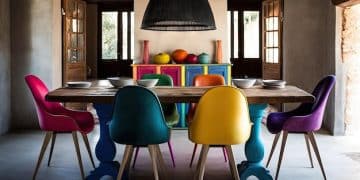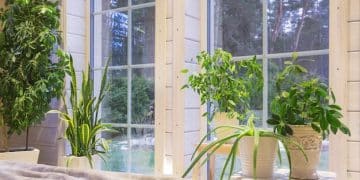Sustainable Style: Eco-Friendly Home Decor Trends in 2025
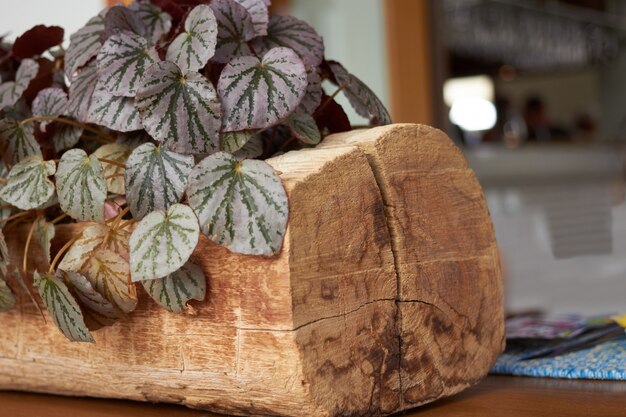
Sustainable style in home decor for 2025 emphasizes eco-friendly materials, repurposed items, energy-efficient solutions, and biophilic designs, reflecting a growing awareness of environmental responsibility.
Discover the future of home decor with sustainable style: eco-friendly home decor trends to watch in 2025, ensuring your living space reflects both your personal taste and commitment to the environment.
Embracing Eco-Conscious Materials
The foundation of sustainable home decor lies in choosing materials that minimize environmental impact. From reclaimed wood to innovative plant-based alternatives, the options are expanding.
As we look to 2025, expect to see even more emphasis on transparency and traceability in the sourcing of these materials, as consumers demand to know the full lifecycle of their home furnishings.
Reclaimed and Upcycled Wood
Using reclaimed wood gives character and history to your furniture and flooring while reducing the demand for new lumber. Upcycled wood takes this a step further, repurposing wood from unexpected sources.
Look for furniture made from reclaimed barn wood or flooring crafted from salvaged materials. These pieces not only add a unique aesthetic but also tell a story of sustainability.
Bamboo and Cork
Bamboo and cork are rapidly renewable resources that offer versatile options for sustainable home decor. Bamboo is incredibly fast-growing, while cork is harvested without harming the cork oak tree.
These materials can be used in flooring, furniture, and even wall coverings, adding a natural and eco-friendly touch to your home.
- Consider bamboo flooring for a durable and sustainable alternative to traditional hardwood.
- Opt for cork wall tiles to add texture and insulation to your living spaces.
- Choose bamboo furniture for its lightweight yet strong properties.
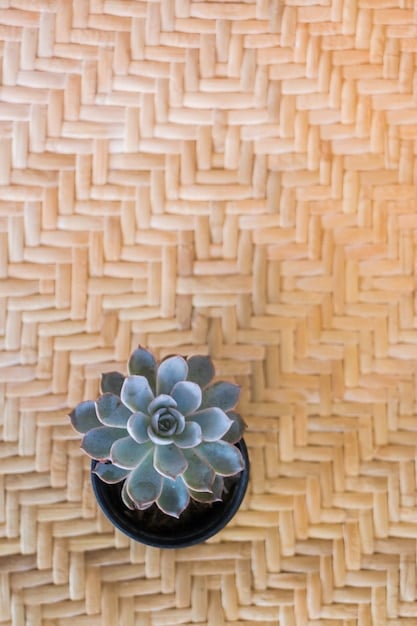
Embracing eco-conscious materials in your home decor is a powerful step towards sustainable living. By making informed choices about the products you bring into your space, you contribute to a healthier planet.
Prioritizing Energy Efficiency
Beyond materials, energy efficiency plays a crucial role in sustainable home decor. From smart lighting to energy-efficient appliances, there are numerous ways to reduce your carbon footprint while enhancing your living space.
In 2025, expect even greater integration of smart home technologies that optimize energy consumption, making it easier than ever to create an eco-friendly home.
Smart Lighting Systems
Smart lighting systems allow you to control your home lighting remotely, adjust brightness levels, and even schedule lights to turn on and off automatically. This not only saves energy but also enhances convenience.
Look for systems that use LED bulbs, which are far more energy-efficient than traditional incandescent bulbs. These systems can be integrated with voice assistants for even greater control.
Energy-Efficient Appliances
Choosing energy-efficient appliances, such as refrigerators, washing machines, and dishwashers, can significantly reduce your energy consumption. Look for appliances with Energy Star ratings to ensure optimal performance.
In addition to saving energy, these appliances often come with advanced features that enhance their functionality and prolong their lifespan.
- Replace incandescent bulbs with LED lights to reduce energy consumption.
- Install a smart thermostat to optimize heating and cooling.
- Choose Energy Star-rated appliances when upgrading your kitchen or laundry room.
Making conscious choices about energy efficiency in your home decor can have a significant impact on the environment. By investing in smart technologies and energy-efficient appliances, you can create a more sustainable and comfortable living space.
Incorporating Biophilic Design Principles
Biophilic design seeks to connect people with nature by incorporating natural elements into the built environment. This approach not only enhances the aesthetic appeal of your home but also promotes well-being and reduces stress.
In 2025, expect to see even more emphasis on biophilic design, as people recognize the importance of reconnecting with nature in their daily lives.
Bringing the Outdoors In
Integrating plants, natural light, and organic materials into your home decor can create a more harmonious and inviting space. Plants purify the air, while natural light enhances mood and productivity.
Consider incorporating large windows, skylights, and indoor gardens to maximize your connection with nature. Use natural materials, such as wood, stone, and bamboo, to create a calming and grounding atmosphere.
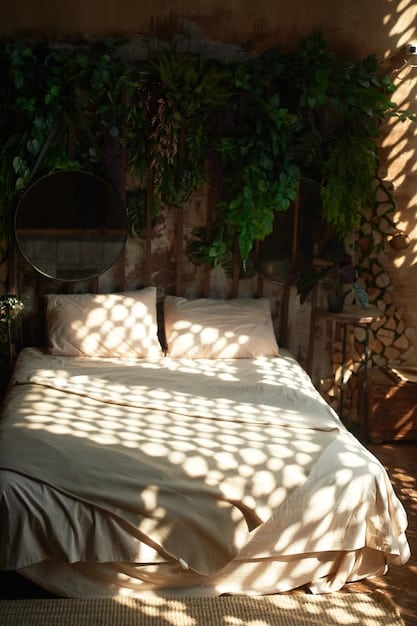
Water Features and Natural Sounds
Adding water features and incorporating natural sounds into your home decor can further enhance the biophilic effect. The sound of flowing water is known to reduce stress and promote relaxation.
Consider adding a small indoor fountain or incorporating nature sounds into your audio system. These elements can create a more tranquil and restorative environment.
- Incorporate plants into every room to purify the air and add visual interest.
- Use natural light to enhance mood and productivity.
- Add water features and nature sounds to promote relaxation.
By embracing biophilic design principles, you can create a home that is not only beautiful but also healthy and sustainable. Connecting with nature in your living space can improve your well-being and reduce your environmental impact.
Embracing Minimalism and Decluttering
Minimalism goes hand in hand with sustainable home decor. By decluttering and focusing on essential items, you reduce waste and create a more intentional living space.
In 2025, expect to see even more emphasis on mindful consumption and the importance of owning less but valuing more.
Focusing on Quality Over Quantity
Investing in high-quality, durable items that will last for years is a key principle of minimalism. This reduces the need for frequent replacements and minimizes waste.
Choose timeless designs that will remain stylish for years to come, rather than following fleeting trends. Prioritize craftsmanship and materials that age gracefully.
Decluttering and Organizing
Regularly decluttering your home can help you identify items that you no longer need or use. Donate, sell, or recycle these items to prevent them from ending up in landfills.
Organize your belongings in a way that promotes simplicity and efficiency. Use storage solutions that minimize clutter and maximize space.
- Declutter your home regularly to remove unnecessary items.
- Invest in high-quality, durable items that will last for years
- Organize your belongings in a way that promotes simplicity and efficiency.
Embracing minimalism not only reduces waste but also creates a more peaceful and intentional living space. By focusing on essential items and valuing quality over quantity, you can create a home that is both sustainable and aesthetically pleasing.
Supporting Local Artisans and Ethical Brands
Supporting local artisans and ethical brands is a crucial aspect of sustainable home decor. By choosing products that are made locally and ethically, you support fair labor practices and reduce your carbon footprint.
In 2025, expect to see even greater demand for transparency and ethical sourcing, as consumers become more aware of the social and environmental impact of their purchases.
Sourcing Locally Made Products
Purchasing locally made products reduces the need for long-distance transportation, which in turn reduces carbon emissions. It also supports local economies and promotes community development.
Look for furniture, textiles, and decorative items that are handcrafted by local artisans. This not only ensures that your purchases are sustainable but also adds a unique and personal touch to your home.
Choosing Ethical Brands
Ethical brands prioritize fair labor practices, environmental sustainability, and social responsibility. By choosing products from these brands, you support businesses that are committed to making a positive impact.
Look for certifications such as Fair Trade and B Corp, which indicate that a company meets high standards of social and environmental performance.
- Shop from local artisans and craftspeople to support your community.
- Choose ethical brands that prioritize fair labor practices and sustainability.
- Look for certifications such as Fair Trade and B Corp to identify responsible companies.
By supporting local artisans and ethical brands, you can create a home that reflects your values and contributes to a more sustainable and equitable world. Making conscious choices about your purchases can have a profound impact on both people and the planet.
DIY and Repurposing Projects
DIY and repurposing projects are a fun and creative way to incorporate sustainable elements into your home decor. By transforming old items into new treasures, you reduce waste and add a personal touch to your living space.
In 2025, expect to see even more innovative DIY and repurposing ideas, as people seek to reduce their environmental impact and express their creativity.
Upcycling Furniture
Transforming old furniture into new pieces is a great way to give your home decor a sustainable makeover. You can repaint, reupholster, or repurpose furniture to create unique and stylish items.
Consider turning an old door into a headboard, or repurposing vintage suitcases into storage containers. The possibilities are endless.
Creating Decorative Items from Recycled Materials
Using recycled materials to create decorative items is another fun and sustainable DIY project. You can turn glass bottles into vases, or use fabric scraps to create patchwork quilts.
Get creative and experiment with different materials and techniques to create unique and personalized home decor items.
- Repurpose old furniture to give it a new lease on life.
- Create decorative items from recycled materials to reduce waste.
- Experiment with different DIY techniques to personalize your home decor.
Engaging in DIY and repurposing projects not only reduces waste but also allows you to express your creativity and add a personal touch to your home. By transforming old items into new treasures, you can create a living space that is both sustainable and stylish.
| Key Point | Brief Description |
|---|---|
| ♻️ Eco Materials | Use reclaimed wood, bamboo, and cork for decor. |
| 💡 Energy Efficiency | Opt for smart lighting and energy-efficient appliances. |
| 🌿 Biophilic Design | Incorporate natural elements like plants and water features. |
| 🔨 DIY Projects | Repurpose old items to create unique decor. |
FAQ
▼
Key materials include reclaimed wood, bamboo, cork, organic cotton, and recycled glass. These options minimize environmental impact and offer stylish alternatives to conventional materials.
▼
Use LED lighting, install a smart thermostat, and choose Energy Star appliances. These upgrades reduce energy consumption and lower utility bills.
▼
Biophilic design connects people with nature through elements like plants, natural light, and water features. Integrate these aspects to improve well-being and create a calming environment.
▼
Supporting local artisans reduces transportation emissions, supports local economies, and promotes fair labor practices. It also ensures unique, handcrafted items for your home.
▼
Try upcycling old furniture, creating vases from glass bottles, or making patchwork quilts from fabric scraps. These projects reduce waste and add unique touches to your decor.
Conclusion
As we look ahead to 2025, sustainable style is set to become the standard in home decor. By embracing eco-conscious materials, prioritizing energy efficiency, incorporating biophilic design principles, and supporting ethical brands, you can create a living space that is not only beautiful and comfortable but also environmentally responsible. Let’s all strive for a future where our homes reflect our commitment to a healthier planet.

